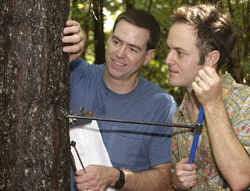
Southern pines appear to grow and conserve water somewhat better in the carbon-dioxide-enriched atmosphere expected by mid-century, a Duke University study has found. However, any growth spurts appear to diminish over time, due at least in part to the kind of hot and dry weather that likely may become more common in the future. Thus, the researchers concluded, enhanced growth of pines may not constitute a long-term sink for human-produced carbon dioxide which might ameliorate global warming.
These findings of a growth ring and wood chemistry study will be described by Duke graduate student Ashley Ballantyne at 9 a.m. Eastern Time on Tuesday, Aug. 9, 2005, during the Ecological Society of America's 2005 national meeting in Montreal.
Ballantyne, a fourth-year doctoral student in paleoclimatology at Duke's Nicholas School of the Environment and Earth Sciences, did his study with research associate Jeffrey Pippen at the Free-Air Carbon Dioxide Enrichment (FACE) experiment.
At the FACE site in Duke Forest, near the university campus, stands of loblolly pines and other tree species are receiving extra CO2 through tower-borne valves under otherwise natural conditions. Results from the enriched trees are compared with those in matched controlled plots not treated with enhanced carbon dioxide.
The FACE experiment is designed to emulate the atmospheric environment that plants will be subjected to if CO2 levels continue to increase as expected due to human activities such as fossil fuel burning. Ballantyne's and Pippen's work was funded by the United States Department of Energy.
Ballantyne said he and Pippen evaluated the pine trees' response to higher-than-normal CO2 levels by measuring annual growth rings in cores extracted from treated and control trees.
Their analysis revealed that pines under elevated CO2 levels experienced 25 percent extra growth in 1999, and a lower 17 percent and 21 percent boost, respectively, during the two previous years. The 1999 level was the maximum measured to date.
Those previous years, 1997 and 1998, "coincided with one of the highest magnitude el Nino events ever recorded," Ballantyne said in an interview. "We suspect el Nino plays some role in regulating soil moisture, probably due to extreme temperatures and changes in seasonal precipitation patterns."
After those most elevated years, enhanced growth in the CO2 began dropping unevenly in a zigzag fashion. In 2000 it was 19 percent. By 2004 it was down to .01 percent. Those years of declining enhancements were marked by "an approximately 15 percent decline in soil moisture during the growth season," he said.
In fact, the uneven year-to-year growth differences seemed more closely related to soil moisture -- the water available for use by the trees -- than to other possible factors. Increased temperatures may cause a decline in soil moisture, thereby suppressing growth, he said.
Other possible factors in growth declines would include the tree stands' increasing ages, and the relatively low amounts of nitrogen in Duke Forest soils drained of nutrients by previous farming, he said.
The Duke researchers also studied how the gas-enriched trees processed carbon dioxide and water by analyzing cellulose in extracted tree wood samples.
During photosynthesis, carbon is drawn from the atmosphere as carbon dioxide to be incorporated into tree tissue, Ballantyne said. At the same time, water is drawn in from the soil through the roots, and some of that water eventually escapes into the atmosphere. Analyzing the chemistry of cellulose "can tell us the relative amounts of carbon gain versus water loss," he added.
The Duke investigators found that under higher-than-normal carbon dioxide levels "more carbon is being drawn in and less water is being emitted into the atmosphere," Ballantyne said. "In future climates, this might be a way for loblolly pines to deal better with water stress or drought."
Most scientists agree that the growing carbon dioxide levels are trapping enough heat to induce global warming. And loblollies and other fast-growing trees have been suggested as possible "sinks" to lock some of the excess carbon dioxide in long-term storage.
Overall, the Duke researchers' findings suggest extra carbon dioxide might enhance loblolly water-use efficiency. But the results may provide less reassurance for proponents of loblolly sink, Ballantyne acknowledged.
"A world with double CO2 is undoubtedly going to be warmer," he said. "However predictions for precipitation changes are not as clear, with some climate models predicting dryer conditions and others wetter.
"If we do see dryer conditions, we might expect less carbon to be stored."